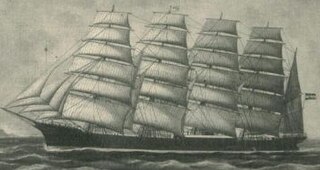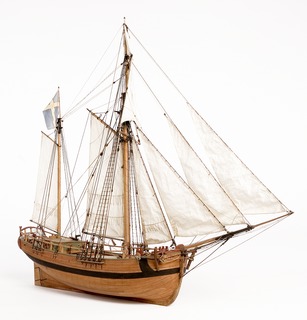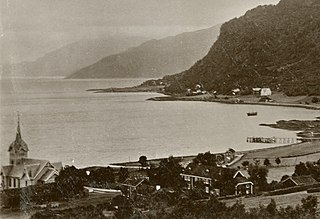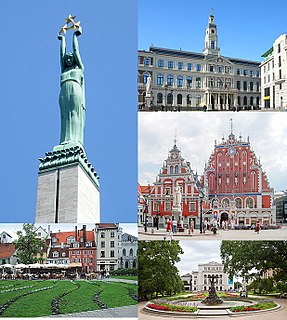
A yacht is a watercraft used for pleasure or sports. The term originates from the Dutch word jacht, and was originally referencing light fast sailing vessels that the Dutch Republic navy used to pursue pirates and other transgressors around and into the shallow waters of the Low Countries. The yacht was popularized by Charles II of England as a pleasure or recreation vessel following his restoration in 1660.

Galleons were large, multi-decked sailing ships first used by the Spanish as armed cargo carriers and later adopted by other European states from the 16th to 18th centuries during the age of sail and were the principal fleet units drafted for use as warships until the Anglo-Dutch Wars of the mid-1600s. Galleons generally carried three or more masts with a lateen fore-and-aft rig on the rear masts, were carvel built with a prominent squared off raised stern, and used square-rigged sail plans on their fore-mast and main-masts.

A tall ship is a large, traditionally-rigged sailing vessel. Popular modern tall ship rigs include topsail schooners, brigantines, brigs and barques. "Tall ship" can also be defined more specifically by an organization, such as for a race or festival.

In the 18th century and most of the 19th, a sloop-of-war in the Royal Navy was a warship with a single gun deck that carried up to eighteen guns. The rating system covered all vessels with 20 guns and above; thus, the term sloop-of-war encompassed all the unrated combat vessels, including the very small gun-brigs and cutters. In technical terms, even the more specialised bomb vessels and fireships were classed as sloops-of-war, and in practice these were employed in the sloop role when not carrying out their specialized functions.

From its modern interpretations to its antecedents when maritime nations would send young naval officer candidates to sea, sail training provides an unconventional and effective way of building many useful skills on and off the water.

M5 is a sloop-rigged super yacht launched in 2003 as Mirabella V. She is the largest single-masted yacht ever built.

Iron-hulled sailing ships represented the final evolution of sailing ships at the end of the age of sail. They were built to carry bulk cargo for long distances in the nineteenth and early twentieth centuries. They were the largest of merchant sailing ships, with three to five masts and square sails, as well as other sail plans. They carried lumber, guano, grain or ore between continents. Later examples had steel hulls. They are sometimes referred to as "windjammers" or "tall ships". Several survive, variously operating as school ships, museum ships, restaurant ships, and cruise ships.

Suomen Joutsen is a steel-hulled full rigged ship with three square rigged masts. Built in 1902 by Chantiers de Penhoët in St. Nazaire, France, as Laënnec, the ship served two French owners before she was sold to German interest in 1922 and renamed Oldenburg. In 1930, she was acquired by the Government of Finland, refitted to serve as a school ship for the Finnish Navy and given her current name. Suomen Joutsen made eight long international voyages before the Second World War and later served in various support and supply roles during the war. From 1961 on she served as a stationary seamen's school for the Finnish Merchant Navy. In 1991, Suomen Joutsen was donated to the city of Turku and became a museum ship moored next to Forum Marinum.

A jackass-barque, sometimes spelled jackass bark, is a sailing ship with three masts, of which the foremast is square-rigged and the main is partially square-rigged and partially fore-and-aft rigged (course). The mizzen mast is fore-and-aft rigged.

The tallship Søren Larsen is a brigantine built in 1949 in Nykøbing Mors, Denmark. Her current homeport is Sydney, Australia.

R. Tucker Thompson is a gaff-rigged topsail schooner based in Opua, Bay of Islands, New Zealand. She is operated as a non-for profit charitable trust and owned by the R. Tucker Thompson Sail Training Trust. The mission of the trust is “Learning for Life through the Sea”. The ship is used for tourism day sails in the Bay of Islands from October through April and for sail training activities between May and September. Youth sail training is particularly focused at youth from the Tai Tokerau Northland region of New Zealand. She is a member of the Australian Sail Training Association (AUSTA), and participated in the American Sail Training Association (ASTA) West Coast Tall Ships Challenge events in 2002 and 2005.

Tradewind is a Dutch topsail schooner. She was built in the Netherlands in 1911 as a herring lugger named Sophie Theresia.

Potosi was a five-masted steel barque built in 1895 by Joh. C. Tecklenborg ship yard in Geestemünde, Germany, for the sailing ship company F. Laeisz as a trading vessel. As its shipping route was between Germany and Chile, it was designed to be capable of withstanding the rough weather encountered around Cape Horn.

HM Bark Endeavour Replica is one of two replicas of HMS Endeavour, the bark commanded by Lieutenant James Cook when he charted New Zealand and discovered the eastern coast of Australia. The initial idea of recreating Endeavour for use as a museum ship was born during the establishment of the Australian National Maritime Museum in the 1980s; the vessel was to be funded by the Bond Corporation and gifted to the nation upon completion. A specialist shipyard was established, complete with viewing platform and guided tours for the public, and construction of the vessel commenced in 1988. Two years later, work stopped because the Bond Corporation hit financial trouble; the Japanese company Yoshiya Corporation stepped in but was also forced to withdraw support because of financial problems.

Bounty was built in 1977/78 for the movie The Bounty starring Mel Gibson and Anthony Hopkins. The ship was decommissioned in 2017.

Southern Swan is a traditional Baltic trader, currently rigged as a three-masted barquentine. She is typical of coastal trading ships from the era 1840s to 1940s.

Anna Karoline is a jekt often called Nordlandsjekt, built at Brataker in Mosvik, Norway in 1876.
Amorina was built as a lightship in 1934 for the Swedish maritime authorities then designated as lightship 33. It was bought by private parties in 1979, converted to have masts installed and competed in the 1983 Cutty Sark Tall Ships Race.

SB Centaur is a wooden Thames sailing barge, built in Harwich, Essex, England in 1895. She was used to carry various cargoes, mainly grain, for the next 60 years. During the First World War she carried food and coal to the French Channel ports. During the Second World War Centaur was damaged when sailing to assist with the Dunkirk Evacuation. She did war work for the duration of the conflict.





























